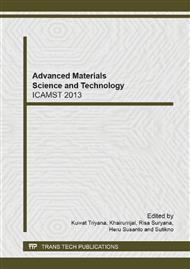p.168
p.175
p.179
p.183
p.187
p.192
p.197
p.203
p.211
Utilization of Natural Porphyrin Thin Films as a Photosensitizer for Photodetectors
Abstract:
In this study, photodetectors were assembled using natural porphyrin as a sensitizer, and their energy gap properties were investigated. The natural porphyrin thin film layered devices used in the experiments were deposited by spin coating on a patterned electrode of Cu printed circuit board substrates. The photo sensitive characteristics were measured both with and without illumination by white light. The photo sensitive effect increased with the number of layers. A maximum current of 2.6 nA was obtained when the films consisted of three layers and the current increased to 7.9 nA for seven layers. To clarify the results, the dependence of the number of layers on the energy gap was evaluated. The experiment results showed that the energy gap decreased linearly with increasing number of layers. The mutual combination of the photo sensitive effect and energy gap indicated that it is possible to apply natural porphyrin as a sensitizer for photodetector applications.
Info:
Periodical:
Pages:
187-191
Citation:
Online since:
February 2014
Authors:
Price:
Сopyright:
© 2014 Trans Tech Publications Ltd. All Rights Reserved
Share:
Citation:


